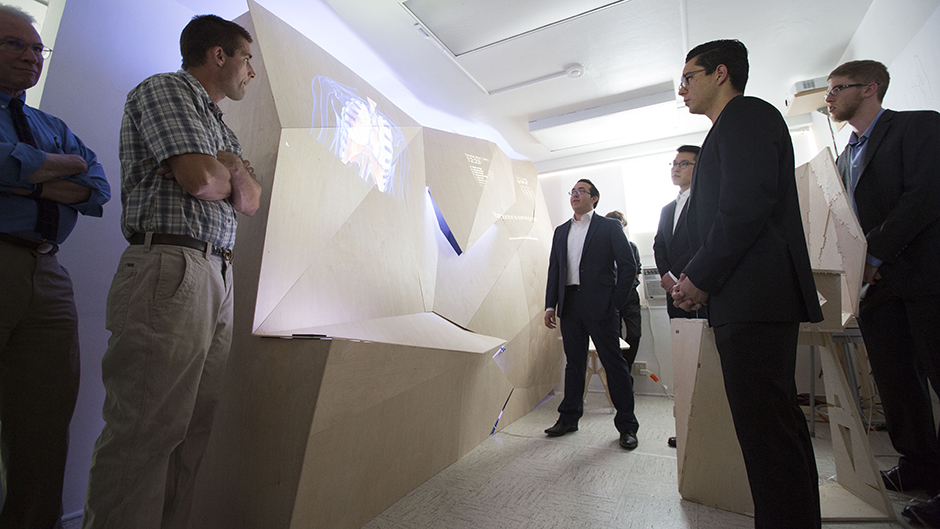In the very near future you may visit the doctor and instead of being greeted by a nurse or a physician’s assistant, you may be welcomed by a talking wall with an Alexa-like voice.
The wall will not only know your name and vital signs but will project images from your IPhone to calm you. For example, if you are fretting about whether you have the flu and anxiously awaiting the doctor, your children’s faces may appear on the wall to soothe you.
The Alexa-embedded interactive medical media shelf wall was among the latest projects created by a group of School of Architecture (SoA) students in the Healthcare Design Studio, which is part of the Healthcare Design program created in 2014 to integrate architecture, engineering and medicine.
“The class’ mission was to create an exam room that was inviting and as stress free as possible,” said Donnie Garcia-Navarro, a fifth-year SoA student who was team leader on the project. “Most exam rooms are not designed properly and there are lots of things that can be improved.”
With that in mind, the students fashioned a full-screen wall, 10 by 4 feet, which projects images, diagrams and crucial patient information to help both the doctor and the patient ease into their meeting.
The project, which was presented at a Florida International University healthcare design colloquium, garnered an invitation for teacher Deborah Franqui, an SoA lecturer, and four UM students to attend the prestigious ASHE 2018 PDC Summit | Adapting to the shifting Tempo of Health Care in Nashville, Tennessee, in March. Franqui co-taught the studio class with Professor Juhong Park, whose area of expertise is technology.
Franqui, a health care architect who has taught at UM for the past three years, said the class decided to build the wall after concluding from their research that embedded technology would improve the delivery of health care by easing patient stress, increasing efficiency for doctors, and providing educational opportunities for patients and their families.
“As we are trying to keep people out of the hospital with preventive care, the exam room is of great interest to the healthcare community,” said Franqui. “The exam room is not only an examination space, but also a consultation space and a place where education happens.”
Once the patient enters the personalized space, the talking wall can project a picture of the doctor with his or her name and title. The embedded technology also allows the wall to ‘’know’’ the patient’s vital signs. A patient can then ask “Alexa” for information about any health condition and the wall will respond, also providing pictures and diagrams for easier learning.
In a later iteration of the space, the studio students imagined building an examination table with technology that would provide the patient’s weight and blood pressure.
“One factor we took into consideration was medical clutter,” said Franqui. “We have items everywhere in an examination room and that can increase the anxiety level of the patient.”
In the UM-created exam room, tongue depressors, otoscopes, syringes, rubber hammers and other medical devices would be behind the wall or embedded in chairs or examination beds. A special sink with a LEED light prompts doctors to wash their hands, then beams the patient information in front of them.
“Unfortunately patients wait a long time in the examination room and, instead of using that time for education, often they have nothing to do,” said Franqui. “I think technology can be a good way of reducing that anxiety through education, knowing who their physician is and having some control over their environment.”
During the class, Franqui and Park invited a group of nurses and members of different architectural firms in Miami-Dade County to assess the room. In the next few months, she hopes to publish the research in one of the health design magazines and apply for funding to further develop the wall.

